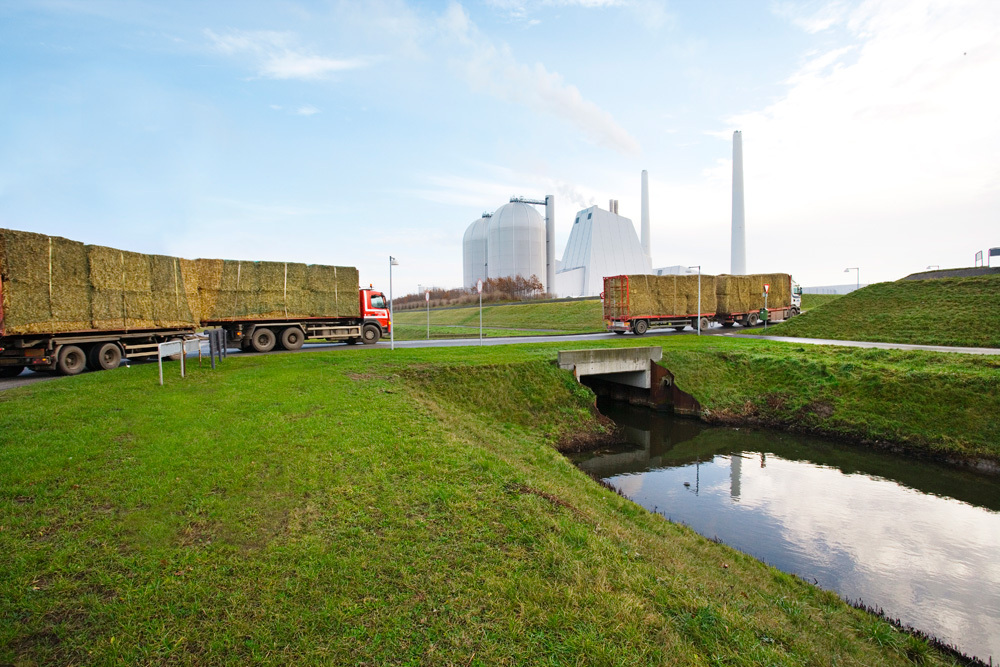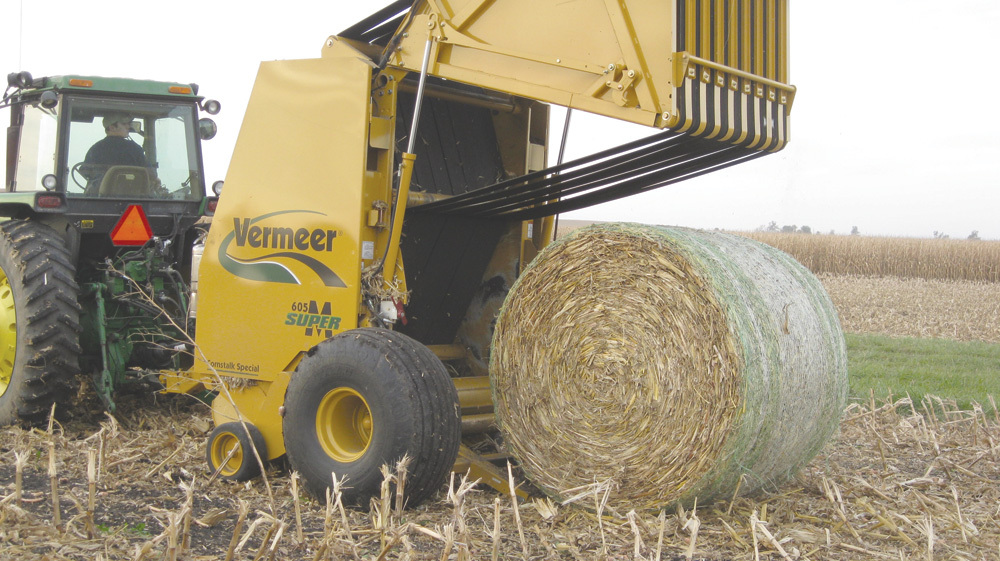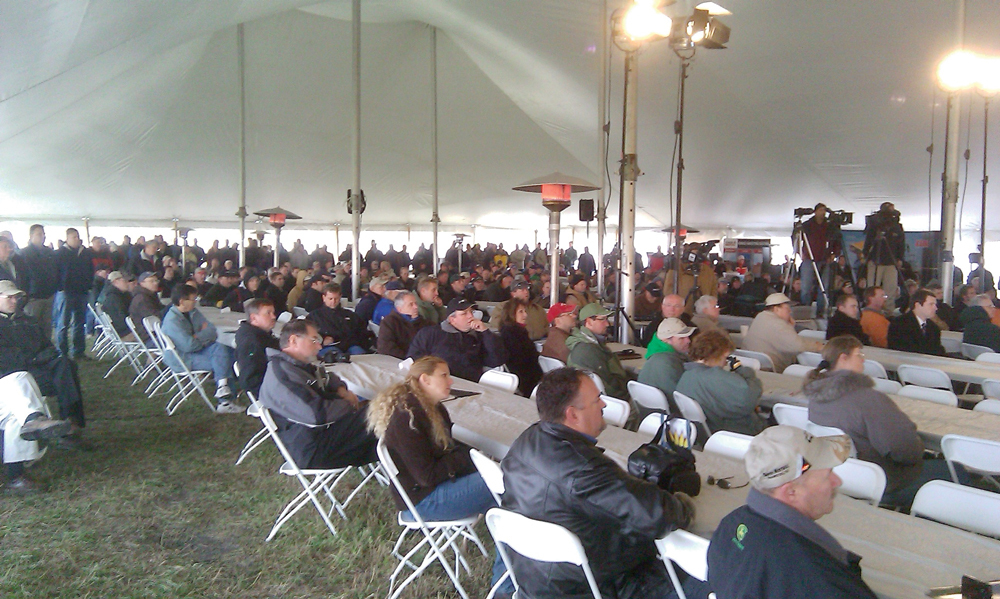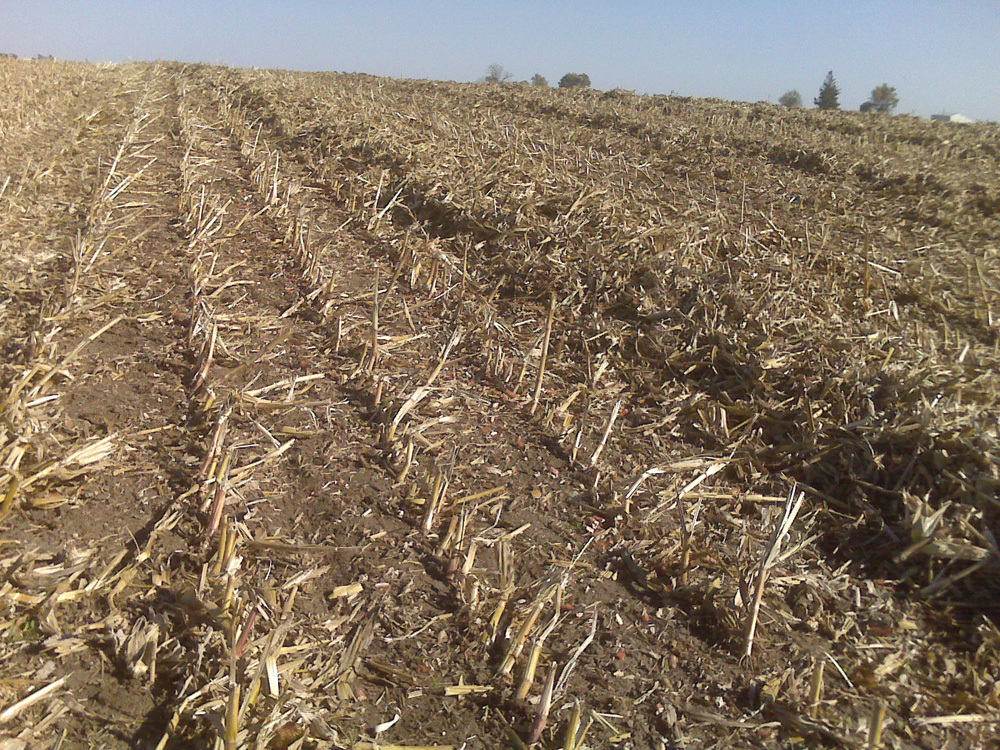The Round and Square of It





PHOTO: INBICON A/S
October 18, 2011
BY Kris Bevill
Three years ago, ag giants John Deere & Co., Archer Daniels Midland Co. and Monsanto Co. pooled their respective areas of expertise and embarked on an experiment. Each company had its own specific reasons for wanting to determine whether stover could truly be harvested from the nation’s corn fields in a sustainable fashion—questions regarding equipment, processing and field productivity, respectively—but without extensive testing of the various harvest, storage and transportation theories, it would be impossible to know whether hypotheticals could become reality. Soils needed to be sampled. Fields had to be harvested. Bales needed to be made, and storage areas needed to be acquired. But, most importantly, they had to get farmers onboard.
Finding Farmers
“Initially, that was difficult,” says Steve Petersen, end-use market manager for Monsanto. At first, many farmers were skeptical of removing stover from their fields for fear that it would be a detriment to soil health. A few exceptions, those with the largest corn on corn yields, were eager to have the excess residue removed, but many were cautious. They needed convincing, and that took a little time. Many farmers who participated in field trials, which took place in the heart of corn country near Cedar Rapids, Iowa, were willing to commit only one field the first year of the project. “But once they gained a comfort level with it and saw that we were not taking all the stover off the ground and that we were doing this in a sustainable manner, we had a lot of them that then put all of their fields in,” Petersen says.
In all, 38 fields were enrolled in the DAM [Deere, ADM, Monsanto] project in 2008, 36 in 2009 and 25 in 2010. Of the farmers who participated, 18 returned every year to contribute their fields to the experiment. Fewer fields were harvested than enrolled, for various reasons, but project leaders determined it is necessary to sign up more fields than needed as a way to mitigate weather and timing issues.
While the project evaluated many of the smaller details of stover harvesting, the overall conclusion was that sustainable stover harvests are certainly possible, but as with everything agriculture, there is no one-size-fits-all approach. “It depends on what your yields are, it depends on what the slope of the ground is, it depends on what the possible wind and water erosion is and it depends on the organic matter of the soils,” Petersen says. “In every area it’s a little different and that’s why we’ve done as much research as we have.”
All uncertainties aside, Petersen is convinced the need to harvest stover will increase. Monsanto has publicly committed to providing corn varieties that will average 300 bushels per acre by 2030 and as corn yields increase, so will stover yields. This will likely inspire more farmers to entertain collaboration opportunities with biorefineries looking for stover. “It becomes a real issue for the grower,” Petersen explains. “They have to either use additional tillage passes or they grow less corn, because they have all of the issues with the residue that's left on the soil. So we want to find a way to make corn stover a coproduct of corn farming and not a byproduct."
The DAM project is not the first, and certainly not the last, to explore the finer points of regularly harvesting ag residues. In Minnesota, long-time ethanol industry consultant Larry Johnson began conducting stover research on behalf of Inbicon A/S, a Denmark-based technology client, after becoming inspired by the wheat straw-to-power practices he saw in use in Denmark. He knew farmers in the U.S. would be getting frustrated with the ever-accumulating amounts of stover in their fields and believed the Danish model for collection and storage of the feedstock could easily be replicated here. In 2009, he began evaluating the logistical challenges associated with collecting, storing and transporting thousands of tons of biomass within the short harvest window.
Custom vs. Farmer
One of the first issues that drew Johnson’s attention was the need for harvesting equipment. Manufacturers and innovative farmers have been developing a variety of implements for harvesting large amounts of stover for a while now, but in order to supply individual farmers with the equipment needed to bring their own stover into ethanol plants, a serious ramp up of manufacturing would be required. Johnson explains the mind-boggling logistical requirements necessary for farmer harvests: “If we need 450,000 tons [of stover] for a 20 MMgy plant, and we’re getting 3 tons per acre, that’ll require 150,000 acres,” Johnson says. “If we’re going to do 500 acres per farmer, that’ll require 300 farmers. If you’re going to harvest right behind the combine, you’d have to have a baler behind 300 separate combines for one plant.” Expanding that view to what he expects could be 100 cellulosic ethanol plants using stover by 2022, Johnson figures manufacturers would need to produce 30,000 stover balers, just for farmers to bale stover for ethanol plants.“Considering that most combines pass no more than one and a half tons of cobs and stover per acre through the combine, that would double the acreage required,” he says. I think that eliminates that possibility.”
Advertisement
Aside from the equipment requirement, another issue with farmers harvesting stover themselves is the unknown quality of the product, he says. “Farmers are aware of how to collect stover and bale corn stover in large round bales. They’ve been doing it for livestock for decades. But they don’t care if they’ve got dirt lumps or roots in there. As an ethanol plant, we are not going to want to see any dirt in there. And sometimes it has a high moisture content, leading to product degradation and shrink.”
Because of these issues, Johnson believes third-party custom harvesters are the only feasible way to collect and deliver stover to ethanol plants. That way farmers don’t have to invest in purchasing or leasing new equipment and third parties can control the quality of the feedstock, as well as handle the storage and transportation aspects. “Farmers will be glad to have people come and take their stover away,” Johnson says. “They don’t want to bother with it.”
Dave Simpson, owner of Sharpsville, Ind.,-based custom harvesting company Simpson Straw Co., says he’s experienced growing interest from farmers who would like to remove excess residue from their fields without having to invest their own time or money. Farmers planting corn on corn, especially, are in need of stover removal because excess residue clogs equipment, he says. His business owns five balers and can cover between 500 and 600 acres per day, harvesting about 10,000 acres of wheat straw and 2,000 acres of corn stover annually. Simpson believes there is enough manpower and equipment available for widespread commercial stover harvests. “There’s no way to make it easier, it just takes hard work,” he says.
Custom harvesters were used for the DAM project trials, and Petersen agrees that most of the stover acquired by ethanol plants will probably be brought in by third parties. “There may be some extremely large farms that may do it as a profit center and have their own equipment, but I think those will be extremely large operators,” he says. “Most of these are going to be custom operators.”
On Their Own
There is one big exception to the growing consensus that custom operators will be key to stover collection. This fall, Poet will begin its third annual stover harvest near Emmetsberg, Iowa, with approximately 100 area farmers participating. Poet continues to believe that farmers can and will deliver the stover necessary to feed its 25 MMgy cellulosic ethanol plant, dubbed Project Liberty, and expects about 70 percent of the participating farmers to harvest the stover themselves. “The farmer has as valued of an interest in this as we do,” says Adam Wirt, regional biomass coordinator for Poet Biomass. “Plain and simple, the way to do this the cheapest is to cut out the middle man. So if the producer is willing and wants to do that work, we know he can do it cheaper than adding in a third party and why not let the money go to his operation if he wants to? Our whole model is built on farmer investment and farmer participation, so this is just another carry on that.” Poet has been conducting stover harvests since 2009 and signs four-year contracts with farmers to collect and deliver biomass to the plant, according to Wirt. Last year, 85 farmers participated in Poet’s stover harvest. This year, all of them returned and brought a few newcomers into the mix, indicating that they are pleased with the results so far.
Square vs. Round
Once the fields are enrolled and a harvest method is determined, the next item on the stover acquisition to-do list is to choose which way the stover should be collected. There are a variety of ways to do it—chopping it into windrows and bagging it or baling it, either into square or round bales. The DAM project explored all of these methods and found that, again, the preferred method will likely vary depending on the geography of the fields and the end-user’s preference. Differing slightly, Johnson has determined that square bales are the most economical method and believes that will be the way most stover is harvested, at least for the near-term. “Large square bales, at this point, are the only way to get maximum tonnage on a semiload of bales,” he says. “And then, once you have it loaded to capacity, it’s much more efficient to travel long distances.” While most of the stover will likely be collected within a 25-mile radius of ethanol plants, Johnson says the square bale method will allow stover to originate as far as 50 miles away from the plant and still be economical.
It is believed that ethanol plants will need specialized processing equipment to handle one particular form of feedstock, be it round bales, square bales, pellets or otherwise. But, once again, Poet is branching out on its own and forging a different path by planning to take in both round and square bales. “We need all the feedstock we can get and until we’re getting that 300,000 tons that we need on an annual basis, we don’t feel we can make the switch to either rounds or squares, nor have we decided that we want to,” Wirt says. “It’s a matter of getting the tons and, if a guy wants to do it one way or another, we’re open to that.”
Advertisement
Storage is another issue directly related to the feedstock’s form. While round bales shed rain, square bales are easier to stack in a storage area. It’s an important determination to make, because proper storage is vital to the feedstock’s longevity and, considering that farmers are lucky to have a 30-day harvest window, ethanol plants need to be prepared to store feedstock adequately for up to 12 months. And that will require a lot of space. Poet has its own relatively small storage yard but plans to ask farmers to store their bales themselves. “If we were going to take on storage, there’s a huge cost,” Wirt says. “Twenty-two acres sounds like a lot, but in terms of overall amount that it can hold for a yearly basis, it’s really small.”
Harmful to Health?
As mentioned, one of the early concerns voiced by some farmers and observers was that stover removal would also remove vital nutrients, potentially damaging the health of the field and perhaps requiring greater use of fertilizers. This concern has largely been debunked through various studies conducted by universities and industry participants. The DAM project found that, on average, the removal of a 1,200-pound round bale of stover equated to an additional $10 worth of fertilizer. For farms that also have livestock operations, as is often the case in Iowa, the manure from livestock delivers so much phosphorous, nitrogen and potassium back to the fields that, for them, removing the stover was an advantage, Petersen says. Additionally, stover removal reduces the number of required tillage passes, which in turn reduces the amount of emissions from farming equipment and wear and tear on the field. Some stover is left behind for protection and the USDA offers planning tools that can help estimate the amount needed to control erosion and provide organic matter. The DAM project utilized those tools and determined they can guide sustainable stover harvests.
Wirt says Poet has engaged several universities to conduct studies analyzing soil health, but when it comes right down to it—the farmer usually knows best. “The farmer’s never going to jeopardize his field or the production or health of it,” he says. “He knows where that limit is.” Wirt believes farmers are more concerned about the timing and financial aspects of stover harvests than studying the health of a field that they already know needs stover removed. “For the time they’re going to put into this, they want to make sure there will be a return on investment,” he says.
Money Talks
The return on investment is also a large part of ethanol producers’ concerns. An economic evaluation of stover harvest activities conducted by Purdue University, sponsored in part by Monsanto, concluded that the total cost of stover collection would likely range between $73 and $90 per dry ton. Assuming custom harvesters are used to collect 15,000 round bales from 5,000 acres of land, harvesting operations would cost about $40 per ton for fields in a corn-soybean rotation. That number is cut almost in half, down to about $23 per ton, when considering corn-on-corn fields because the stover harvest would eliminate one tillage pass, the researchers found. Once the stover is harvested, Purdue economists estimate that loading and unloading the bales would cost about $7 per ton, transporting them adds another $23 per ton, assuming 26 round bales are hauled 42.4 miles on a flatbed trailer, and storing the bales onsite under a tarp for 12 months would cost about $19 per ton.
Purdue’s calculations provide an easy breakdown of the various input costs required to bring stover from the field to the factory, but it is important to remember that commercial facilities may require at least 300,000 dry tons of feedstock annually. Using that figure as a starting point, and assuming that each round bale weighs 1,200 pounds, Purdue’s high-end calculation of $90 per dry ton in total costs equals a total cost of $27 million annually to collect, store and transport stover to a nearby ethanol plant.
“It’s going to take some serious financing,” Johnson says. The Purdue economic evaluation didn’t include payments to farmers, which will add even more to ethanol producers’ initial out-of-pocket expenses because, as Johnson points out, farmers are skeptical when it comes to IOUs. “Especially after the debacle with VeraSun Energy Corp., farmers are not going to be likely to let you take the stover without at least a large down payment,” he says. Also, farmers aren’t likely to be clamoring over each other to jump on with a project that hasn’t been built yet, and banks aren’t seemingly too excited to finance a project without guaranteed feedstocks. Johnson believes that’s where the government should step in. “It all ties together and, in my mind, that is a role for government to be able to see this vision and, if not guarantee the capital to make it happen, at least put together some reasonable energy policies so that the private sector can see that this has a future.”
The first federal steps in that direction finally came in late summer when the U.S. DOE finalized loan guarantees for Poet’s Project Liberty and Abengoa’s cellulosic ethanol plant near Hugoton, Kan. Certain Congressional members continue to wage war against the renewable fuel standard (RFS), however, and the U.S. EPA will issue its final decision by the end of November on next year’s RFS volumes, once again lowering the cellulosic biofuels mandate in the face of lagging production options. It’s a worrisome signal to some investors, but those involved in the actual stover harvest activities believe it will soon become standard practice in many areas of the Corn Belt. Petersen notes that land surrounding ethanol plants happens to be particularly well-primed for stover harvests, which is a benefit to plants considering bolt-on cellulosic additions. Fields surrounding ethanol plants are typically flat, many of them are planted with corn-on-corn and yields are very high, Petersen says. “In those areas, you’re going to see stover harvests on an annual basis,” he predicts.
Johnson says that given enough money and manpower, large-scale stover harvests could happen this fall. Realistically, however, stover harvests probably won’t start ramping up until next year at the earliest, which still puts it on track with the building schedule of the first few commercial-scale plants. According to Johnson, Inbicon has several cellulosic ethanol projects in the U.S. in planning and preliminary engineering phases, but policy is a factor in getting them started. “These projects will be ready to go when the conditions are right,” he says.
As for the first step of the stover puzzle—getting farmers to agree to participate—Petersen, Johnson and Wirt all say education and information is the key. Petersen recommends a good testing protocol to show exactly what you are removing from the farmer’s fields, backed up with information to illustrate how it can be done sustainably as a way to convince them to participate. Wirt says education is the main area of focus for Poet when working with farmers on stover harvests and he believes that coordinated efforts between ag producer and ethanol producer will be a success. “We may not know all of the answers and they may not either, but we’re working together to try to get the best results,” he says. “So far, it’s working for us. This is a matter of all of us succeeding together, no matter the pathway. It’s a matter of figuring out how we collect stover as one part of the giant scheme of converting that into energy. We all need to be successful in this.”
Author: Kris Bevill
Associate Editor, Ethanol Producer Magazine
(701) 540-6846
kbevill@bbiinternational.com
Upcoming Events





